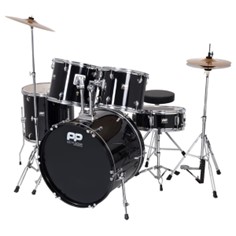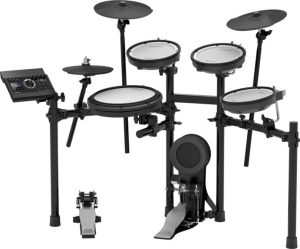This guide consists of several pages. You can access each section by clicking on the respective links in the table of contents on the left side of this page.
The MusicPower Team
Drum Set Components
In general, a drum set typically consists of three main parts: the drums, the cymbals, and their respective stands. Drums and cymbals are often considered two separate groups of instruments because their usage can vary significantly depending on the genre of music. The stands are responsible for stability and their use, but we will discuss them later.
Unlike most musical instruments, a drum set is made up of many individual pieces. An experienced drummer usually has a good idea of what they want from their drums and may “customize” their set with carefully selected elements. For beginners, it’s often easier to start with a pre-configured and complete set. While an adult beginner may choose a contemporary standard setup with a 22″ bass drum, a studio kit with a 20″ bass drum might be the better choice for children.
A complete drum set for beginners typically includes the following:
- 10″ x 7″ Tom
- 12″ x 8″ Tom
- 2x Tom Mounts
- 16″ x 16″ Floor Tom
- 22″ x 18″ Bass Drum
- Bass Drum Pedal
- Hi-hat Stand
- 14″ Hi-hat Cymbals (top and bottom)
- Snare Stand
- 14″ x 5.5″ Snare Drum
- Cymbal Stand
- 16-18-20″ Crash/Ride Cymbal
- Drum Throne (seat)
- Drumsticks

Many drum kits include most of the items mentioned above, but in some sets, cymbals may not be included, nor the drum throne (seat), and drumsticks. These items need to be purchased separately.
Bass Drum and Bass Drum Pedal
The bass drum, sometimes referred to as the kick drum, is the largest drum in a drum kit. It plays a significant role as it usually sets the rhythm along with the snare drum. In many music genres, it provides a stable, powerful foundation that interacts with the bass part to establish the basic beat. Bass drums come in various sizes, with jazz drummers often preferring smaller kick drums (sometimes nearly as small as a floor tom), while rock music is dominated by kick drums sized 22″ and above.
The bass drum is the only element of the drum set played exclusively with the foot, using the bass drum pedal. Standard models, such as those commonly included in beginner drum kits, have moderate chain resistance and a beater. An advanced player can experiment with various models to find the one that suits them best and allows for further improvement. Most beginner models provide the option of different adjustments so you can customize the pedal to your liking. The sound can vary significantly depending on the beater’s hardness.
There are also double bass drum pedals, also known as double pedals, which are popular among advanced drummers, especially those playing harder music genres like heavy metal. They allow you to play fast passages with both feet. Some manufacturers offer expansion kits to convert their single pedals into doubles, meaning you don’t have to leave your single pedal collecting dust when transitioning to a double. In recent years, direct drive systems (as opposed to traditional chains) have become popular in double pedals.
Snare Drum
The snare drum, not only plays a crucial role but also significantly contributes to the sound of the entire band or ensemble. Its name comes from the sound of its snares, a set of thin wires stretched across the membrane on the bottom part of the drum. It has an adjustable mechanism and produces a characteristic sound when the drum is struck. Depending on the tension of the snares, this sound can be crisp and short or more prolonged.
Its distinctive sound and central position make the snare drum a key element of the drum set. Its sound stands out among the instruments of the band and can have a decisive impact on the character of a song. Whether you choose a snare drum with a metal or wooden shell depends on your preferences for the fundamental sound. Metal snares tend to have a brighter sound, while wooden snares deliver a warmer tone. However, remember that the material is not the only criterion for the sound – its thickness and, finally, the tuning contribute to its sound. A very thick wooden shell may sound much clearer and penetrating than a thin aluminum shell. The depth of the snare drum is also important. Very shallow snares (Piccolo snare) tend to have a more compact sound, while wider models, sometimes sound as deep as Toms and can produce a more rounded sound that may be more suitable for rock music.
Toms
Toms are available in various sizes that directly impact their sound intensity. Small toms produce a shorter and more compact sound, while large toms have a greater “tail” in their sound due to their larger diameter. They are divided into two categories. The first type is mounted above the bass drum, while the second type is placed on the floor – the so-called floor tom. Each manufacturer has its own version of the tom support system, which must be durable enough to withstand frequent hits.
The basic pattern is the same for all drums: they are constructed from several layers (approximately 6-9) of wood. There is usually a small opening for the release of air pressure. Both drumheads (top and bottom) are placed on the rim, which is screwed with tension rods that adjust the tension of each drumhead, thus tuning them. The more tension rods, the easier it is to achieve uniform tuning.
To achieve good tuning, it is important for the base surface to be smooth and even. The rim must be fully circular and flat. Fortunately, even today, the most affordable drum kits tend to be well-constructed in these areas.
Bases
Bases consist of all the items used for the placement and positioning of various elements of the drum set: a base for the snare drum, a base for the hi-hat, bases for cymbals, etc.
Rigidity and durability are crucial criteria for evaluating bases in a drum set. Additionally, the weight should not be underestimated. Many bases are made from lightweight metal alloys. Heavy bases made of solid metal have largely been replaced by lighter models. Durability of the adjustment screws is another criterion, as they need to withstand many cycles of intense tightening without wearing out.
Hi-Hat Stand
The hi-hat is the second element of the drum set played partially with the foot. Similar to the bass drum pedal, the most important criteria are the smoothness of the mechanism and its durability. Through a push rod and a set of springs, the hi-hat stand raises the top cymbal a short distance above the bottom one. Pressing the pedal closes the hi-hat, bringing the top cymbal down to meet the bottom one, creating the characteristic sound. Releasing the pedal allows the springs to return the top cymbal to its initial position.
Cymbal Stands
A typical beginner drum set usually includes a cymbal stand. It can be straight up or have a boom arm. Boom stands allow for a closer and more flexible placement of cymbals. However, the further the cymbal is placed from the center of gravity of the stand, the less stable the structure will be. Therefore, boom stands require more floor space. You can expand your set by adding any cymbal stands you desire.
Drum Throne
Most beginner drum sets include a drum throne. Due to budget constraints, many beginners choose the cheapest model they can find. However, consider that you may be sitting for many hours when practicing. In this case, an uncomfortable throne can quickly become a problem. You may want to invest in a throne with greater stability and better comfort.
Cymbals
Cymbals significantly contribute to the overall sound of the drum set. For this reason, they must be chosen with particular care. The variety is vast, ranging from inexpensive cymbals made of brass to handmade ones crafted from high-quality B20 metal alloys. There’s something different for every budget and sound preference!
Drum sets usually do not include cymbals unless they are beginner sets. For beginners, a hi-hat, a ride, and a crash cymbal are generally sufficient. Splash and China cymbals are optional and can be added later.
Hi-Hat Cymbals
The hi-hat consists of two cymbals sold as a pair. The most common diameter is 14 inches (referring to the diameter of each cymbal). Both cymbals are mounted on the hi-hat stand and can be played with both foot and drumsticks. By opening the hi-hat to various degrees, a variety of different sounds can be produced.
Ride Cymbals
These cymbals usually have a diameter of 20 inches and are the second accompanying cymbal of the set, with the hi-hat being the first. Like the hi-hat, it is primarily used in steady beats to complement the rhythm. Thicker cymbals have more tone, making them a good choice for louder styles, while thinner ones can be used as large crash or crash/ride cymbals. The bell in the center of the cymbal produces a distinctive and punctuated sound.
Crash Cymbals
Crash cymbals are mainly used for emphasis within a song arrangement, especially on the downbeat after a turnaround or fill-in. In some styles, crash cymbals can also be used to play steady, accompanying rhythmic patterns like the hi-hat and ride. The most common size for crash cymbals is 16 inches. Advanced players may consider adding a second, larger diameter crash to increase their sound options.
Drumsticks
Of course, you will need drumsticks to play the drums. A good starting point for beginners is size 5A drumsticks (medium thickness, medium weight, and length). Drumsticks are available in various woods, profiles, thicknesses, lengths, and weights, and their tips can have different shapes and materials. Hickory and maple are the most common wood choices. Wooden tips with a large contact area produce a softer sound compared to the hard but durable plastic tips. There are also carbon-fiber drumsticks such as Carbostick and Fiberstick for a more balanced play and greater durability.
Depending on the weight and length of each drumstick, you will feel and react differently. This affects the power (force in the strike) and rebound. While a drummer can compensate for the weak points of a drumstick with various playing positions, this may have negative effects on their power and endurance during play. Drumsticks are consumables, and you should always have a spare pair on hand.
Drums Setup
The setup of the drum kit should be arranged in the most ergonomic way possible. You should be able to reach each drum comfortably, using minimal force. Non-anatomical and tiring positions and movements of the hands and feet should be avoided. Start by placing the bass drum and the snare drum, then the Hi-hat. Once these are set up and look fine, add the toms and complete the setup with the cymbals. When you find a configuration that suits you, it may be useful to mark the positions of the stands and drums in your space, so you can remember it in the future. Good practice!
If you’re facing space constraints and want a quieter option, take a look at the guide for Electronic Drum Kits that we have prepared for you.




